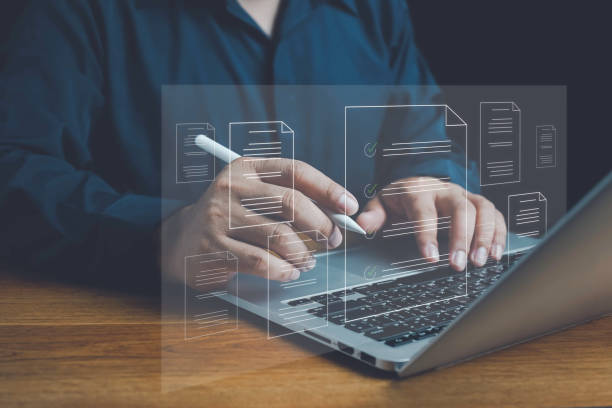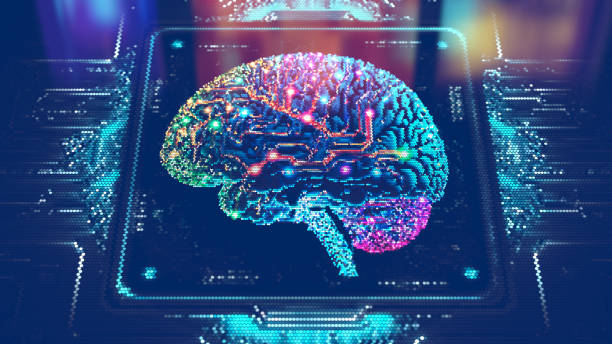### What is Internal SEO and Why is it Important?
[Image: A magnifying glass focusing on “webseo” with a search engine optimization concept]
**Internal SEO** or On-Page SEO refers to the set of actions taken within a website to improve its ranking in search engines.
These actions include optimizing content, site structure, HTML tags, and other internal elements of the site.
The importance of internal SEO lies in helping search engines better understand the site’s content and display it to users with relevant keywords.
A site with strong **internal SEO** has a greater chance of achieving high rankings in search results and attracting organic traffic.
In other words, **internal SEO** is a fundamental foundation for success in the online world.
Using appropriate and relevant #keywords, proper content structuring, and providing a desirable user experience are among the main pillars of **internal SEO**.
>Is your company’s website as professional and trustworthy as it should be? Create an online presence with a specialized corporate website design by Rasaweb that reflects your credibility and attracts more customers.
>
>\✅ Build a powerful and professional image of your brand
>
>\✅ Convert visitors into real customers
>
>\⚡ Get a free consultation now!
### Keyword Research; A Foundation for Internal SEO
[Image: Woman using a smartphone for online payment with icons on a virtual screen]
Keyword research is the first step and one of the most important steps in **internal SEO**.
Choosing the right keywords helps you optimize your content for phrases that users are actually searching for in search engines.
Various tools such as Ahrefs, Ubersuggest, and Google Keyword Planner can help you with this.
When choosing keywords, consider factors such as search volume, competition, and the keyword’s relevance to your site’s content.
Long-tail keywords often have less competition and can attract more targeted traffic to your site.
After choosing keywords, use them naturally and strategically in titles, meta descriptions, body text, and other elements of your site.
Remember that the ultimate goal is to provide valuable and relevant content to users, not just to fill the page with keywords.
A proper keyword strategy greatly helps improve your **internal SEO**.
### Optimizing Titles and Meta Descriptions
[Image: Digital marketing for promotion of products with social media]
Title tags and meta descriptions are among the most important HTML elements that are displayed in search results.
The page title should be concise, engaging, and include the main keyword.
The page title length should not exceed 60 characters to be fully displayed in search results.
The meta description should also provide an engaging and compelling summary of the page’s content.
The meta description length is usually between 150 and 160 characters.
A good title and meta description can increase your site’s click-through rate (CTR) and drive more traffic to your site.
When writing titles and meta descriptions, consider the needs and desires of users and try to answer their questions.
Optimizing titles and meta descriptions is one of the most important factors in improving **internal SEO**.
**Internal SEO** requires attention to detail, and title and meta tags play a vital role in this regard.
The table below shows an example of optimized and non-optimized title tags:
“`html
“`
“`html
Yes
No
Yes (Less than 60 characters)
No (More than 60 characters)
Yes
No
Yes
No
“`
### Optimizing Content for SEO and Users
[Image: Woman working with a computer laptop for managing search]
Content is the king of **SEO**.
High-quality, valuable, and relevant content not only helps improve your site’s ranking in search engines, but also attracts and retains users on your site.
When producing content, consider the needs and questions of users and try to provide content that helps them.
Use keywords naturally and strategically in your text, but avoid overusing keywords.
Update your content regularly and try to produce new and fresh content.
Use images, videos, and other multimedia elements to make your content more attractive.
Internal and external linking can also help improve the **internal SEO** of your content.
High-quality content should have a well-organized and readable structure.
**Internal SEO** helps content be better seen in search results.
>Don’t have a corporate website yet and are missing out on online opportunities? With professional corporate website design by Rasaweb,
>
>\✅ Double the credibility of your business
>
>\✅ Attract new customers
>
>\⚡ Free consultation for your corporate website!
### Optimizing Images
[Image: AI technology businessman touching brain working data and algorithms]
Images play an important role in the attractiveness and user experience of a site.
However, unoptimized images can slow down site loading speed and reduce **SEO** ranking.
To optimize images, use the appropriate format (such as JPEG for images with high detail and PNG for images with simple graphics).
Reduce image sizes using image compression tools.
Use alt text to describe images.
Alt text helps search engines understand the content of images and is displayed to users if the image fails to load.
Name image files with relevant keywords.
Optimizing images is an important aspect of **internal SEO** that should not be overlooked.
Alt text should be descriptive and concise and naturally include the relevant keyword.
### Internal and External Linking
[Image: Cyber login and password concept with a smartphone data protection]
Internal linking means creating links between different pages of a website.
Internal linking helps search engines better understand the site structure and identify more important pages.
Also, internal linking helps users easily navigate your site and find the content they are looking for.
External linking means creating links from other sites to your site.
External links (Backlinks) from reputable and relevant sites help improve the credibility and **SEO** ranking of your site.
Internal and external linking both play an important role in improving the **internal SEO** and overall SEO of your site.
When internal linking, use appropriate and relevant anchor text.
The anchor text should clearly describe the content of the page you are linking to.
For external linking, try to get your links from reputable and high-quality sites.
**Internal SEO** can be improved with the correct use of links.
### Optimizing URL Structure
[Image: CEO business concept chief executive officer financial background]
The URL structure of your site’s pages should be clear, concise, and include relevant keywords.
URLs should be understandable for users and search engines.
Avoid using long and complex URLs that contain meaningless numbers and letters.
URLs should be as short and descriptive as possible.
Using keywords in the URL can help improve **internal SEO**.
Use a hyphen (-) to separate words in the URL.
For example, instead of using a URL like example.com/page123, use a URL like example.com/seo-internal-guide.
Optimized URLs are an important factor in improving your site’s **internal SEO**.
URL optimization improves ranking in search engines.
“`html
“`
“`html
Yes
No
Yes
No
Yes
No
Yes
No
“`
### Improving Site Loading Speed
[Image: Digital online marketing businessman using tablet and analysis]
Site loading speed is an important factor in user experience and **SEO** ranking.
Users expect site pages to load quickly.
If your site is slow, users will leave it and visit other sites.
Search engines also care about site loading speed and rank faster sites higher.
To improve site loading speed, you can use various tools such as Google PageSpeed Insights.
These tools help you identify your site’s speed issues and find solutions to fix them.
Optimizing images, using a CDN, reducing code sizes, and enabling Gzip compression are some of the actions you can take to improve your site’s loading speed.
**Internal SEO** is heavily influenced by site speed.
>Research shows that 80% of customers trust companies with professional websites more. Does your current website earn that trust?
>With Rasaweb’s corporate website design services, solve the problem of customer distrust and weak online image forever!
>
>\✅ Create a professional image and increase customer trust
>
>\✅ Attract more sales leads and grow your business
>
>\⚡ Get a free consultation
### Optimizing for Mobile
[Image: Concept of systems applications and products in data processing]
Today, most users access the internet through mobile devices.
Therefore, optimizing your site for mobile is one of the most essential steps in **internal SEO**.
Your site should be optimized for display on different devices with different sizes.
Responsive sites automatically adapt to the user’s device screen size.
In addition to being responsive, your site should also be optimized for mobile in terms of loading speed and user experience.
Google gives more importance to mobile-friendly sites and ranks them higher.
Optimization for mobile is considered an important factor in **internal SEO**.
### Monitoring and Analyzing Results
[Image: Data insights]
**Internal SEO** is an ongoing process that requires monitoring and analyzing results.
You should regularly check your site’s performance in search engines and make the necessary changes.
Tools like Google Search Console and Google Analytics help you get useful information about site traffic, popular keywords, click-through rate, and other important metrics.
By analyzing this information, you can identify the strengths and weaknesses of your **internal SEO** strategy and take the necessary steps to improve your site’s performance.
**Internal SEO** requires continuous review and analysis to achieve the best results.
By reviewing the results, you can improve your SEO strategy.
#### Frequently Asked Questions
“`html
Number
Question
Answer
1
What is Internal SEO (On-Page SEO)?
Internal SEO refers to the set of actions performed within a website to optimize its pages for better ranking in search results.
2
What is the most important factor in internal SEO?
High-quality, relevant, and comprehensive content that meets the user’s needs is the most important factor in internal SEO.
3
What role does the Title Tag play in internal SEO?
The Title Tag is one of the most important factors that tells search engines and users what the page’s content is about. It should include the main keyword and be engaging.
4
How important is the Meta Description Tag?
Although it does not directly affect ranking, it is very effective on the click-through rate (CTR) in search results and encourages users to visit the page.
5
How is image optimization done in internal SEO?
By using an appropriate alt tag, compressing the image size to increase loading speed, and naming the image file meaningfully.
6
What is the importance of using headings (H1, H2, H3) in internal SEO?
Headings help structure content, increase readability, and help search engines understand the hierarchy and subtopics of the content.
7
What does internal linking mean and what are its benefits?
Internal linking means creating links between different pages of a website. This helps distribute credit, improve user navigation, and help search engine crawling.
8
Where should the Focus Keyword be placed on the page?
The main keyword should be in the title tag, meta description, H1, first paragraph, and naturally throughout the text and, if possible, in the URL address.
9
What effect does copy or duplicate content have on internal SEO?
Duplicate content can harm site rankings and confuse search engines as to which version is the original and may identify it as spam.
10
How important is page loading speed in internal SEO?
Page loading speed is an important ranking factor and directly affects user experience. Slow pages increase user bounce rates.
“`
**And other services of Rasa Web Advertising Agency in the field of advertising**
**Smart Website Development:** A professional solution for online growth with a focus on SEO-driven content strategy.
**Smart UI/UX:** Designed for businesses looking to increase click-through rates through marketing automation.
**Smart Content Strategy:** Designed for businesses looking to grow online through attractive user interface design.
**Smart Brand Identity:** A professional solution for managing campaigns with a focus on SEO-driven content strategy.
**Smart Social Media:** An effective tool for increasing sales with the help of real data.
**And more than a hundred other services in the field of internet advertising, advertising consulting, and organizational solutions**
**Internet Advertising | Advertising Strategy | Advertorial**
#### Resources
[On-Page SEO Optimization at Moz](https://moz.com/learn/seo/on-page-optimization)
,[The Complete Guide to On-Page SEO at SEMrush](https://www.semrush.com/blog/on-page-seo/)
,[On-Page SEO: A Complete Guide by Ahrefs](https://ahrefs.com/blog/on-page-seo/)
,[The Guide to On-Page SEO at Search Engine Land](https://searchengineland.com/guide/on-page-seo)
? In today’s digital world, your business success is just a click away. Rasaweb Afrin paves the way for you to be seen by offering comprehensive digital marketing services including custom website design, SEO, and social media management. With us, your brand will shine at its peak.
📍 Tehran, Mirdamad Street, next to the Central Bank, South Kazerun Alley, Ramin Alley No. 6
✉️ info@idiads.com
📱 09124438174
📱 09390858526
📞 02126406207



